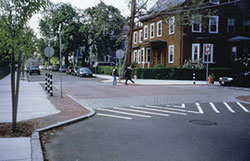Engineering Solutions to Pedestrian Safety
Cambridge, Massachusetts
Source: Pedestrian and Bicycle Information Center (PBIC)
Problem
Cambridge lacked a comprehensive plan to improve the pedestrian environment.
Background
Cambridge unveiled its Pedestrian Plan in 2002 in an effort to remove themselves from the list of metropolitan areas not meeting the Federal Clean Air Act requirements. The city recognized the automobile as a major source of air, water, and land pollution and that the majority of trips in Cambridge were short trips most easily replaced by walking. So the city undertook a plan that would improve the walking environment and reduce automobile trips.

A roadway improvement in Cambridge as part of the Pedestrian Plan.
Solution
In addition to many innovative education campaigns, the city took on roadway redesigns, sidewalk improvements and repair, crosswalk markings, signal improvements, traffic calming projects, and the installation of lighting and street furniture in priority spots.
Additionally, Cambridge developed a questionnaire to elicit residents' opinions of traffic-calming projects after their completion. Responses were used to improve future projects.
Results
An evaluation of ongoing changes has not occurred, although circumstantial evidence shows that sidewalk maintenance has improved in the city, largely due to greater enforcement of local ordinances. For instance, the city requires property owners to keep sidewalks clear of snow and ice and to trim vegetation; such preventative measures reduce repair costs in the long run.
Contact
Cara Seiderman, Transportation Program Manager
cseiderman@cambridgema.gov
Image Source
Parenti, Jeff. "Cambridge Plans A Livable Community." Turner-Fairbank Highway Research Center. http://www.fhwa.dot.gov/publications/publicroads/06nov/03.cfm




